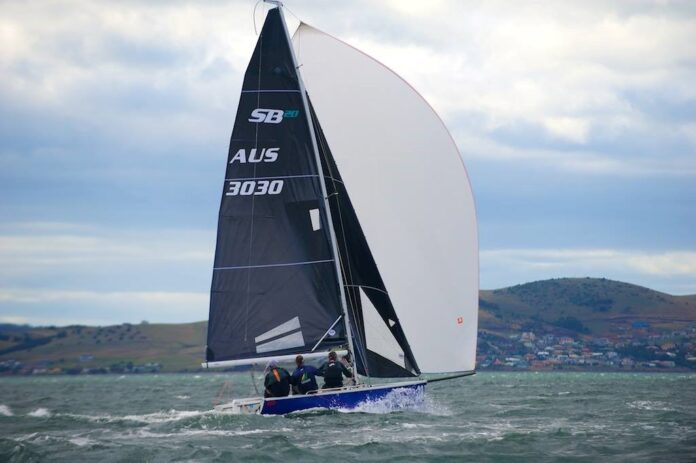

Following are excerpts from an interview I did with Glenn Bourke regarding Fleet Strategy.
Glenn is an Olympian, an Americas Cup crew, an Ocean racer and a multiple world champion in several classes.
He is known for his attention to detail and meticulous approach to preparation and then execution out on the racetrack.
FREE BOOK – TIPS FROM SAILING LEGENDS
BRETT: Do you develop a regatta game plan?
GLENN: You have your aspiration in the beginning and you’re trying to learn about the venue and understand what you think the idiosyncrasies of that venue are, so you’re capable of making changes as you need them.
The plan will change based on the input that you get. I think the sailing strategy is very much like playing chess. What’s the other guy done relative to what you’ve done? And can you factor that in, in a quick way and be adaptable enough to alter the destiny of a race or a leg, or the regatta itself?
So it’s always, moving pawns and moving knights and whatever else. And you’re trying to, I think it’s an actuarial kind of composition. I’m always thinking about the numbers in the event.
Where am I? If I’m 30th at the top mark and I need to get into the top 10, I’m going to be a bit more aggressive at the bottom. That I’ve got to get myself clear, I’ve got to get to the favoured side of the course.
I’ve got to take a little bit more of a risk to try and get myself up to 10th because I know that counting a 30th is going to hurt me. And you’ve got to be adaptable all the time like that.
If I’m first around the top mark, I know that I’m going to leg it on port tack from out of the bottom mark. I will then cover the fleet and try and make people do what you want them to do. To shut the race down, to get the least reaction out of the fleet.
If there’s one guy that’s inconsequential to the event, I’m going to let him go and hope that my plan’s better than his.
FREE BOOK – TIPS FROM SAILING LEGENDS
BRETT: How do you plan an approach the lay line in a big fleet and you’re back 15th or worse?
GLENN: Again, you got to be adaptable. And if you’re coming in under the lay line, and somebody crosses in front of you or just behind you and opens a track up, you need to get out to that starboard hand lay line.
Ultimately the only defence you have is being on the starboard hand lay line and in clear air.
So if a guy ducks you and he’s creating a hole for you, tack on his hip. Take a dig out, get to the lay line, and come back again. Don’t get trapped at the top mark doing a series of doughnuts trying to find a hole.
Don’t get caught late, be preemptive and make your decisions early. Understand that if you’re really deep, they’re going to rack up further and further outside the starboard hand lay line.
Occasionally if you’re in 30th place, stay to the left and then find a hole coming back in.
If you’re in the top 20 at the top mark, don’t be that guy that gets trapped out at the mark.
You know, they tack, they don’t give room. They’ve got to run behind 15 boats before they can find a hole to tack into. You’ve really got to be pre-thinking it as much as you can.
FREE BOOK – TIPS FROM SAILING LEGENDS
BRETT: When is it prudent to stay with the fleet?
GLENN: Always, always when you’re constructing a regatta win. It’s safer to stay with the fleet. I would much prefer to have a third with no risk than a first with a medium amount of risk.
If I’m constructing a regatta, I’m trying to get on the podium every day, you know? Can I get a decent result every day? And I know that the more I hang it out there and do dramatic things, the greater the risk.
So if the fleet splits in two, and half go left and half go right, you got to take a punt on which side you think is correct. If the fleet is predominately going right, and three guys go left, don’t worry about the left guys.
Stay with the fleet because you know the worst you’re going to get is a fourth place, and you can count that, and you’re all happy. And your main players are on your side of the course.
So it’s an accounting function where you just trying to work out risk versus reward all the time. But if you’re fast, there’s even more reason to stay with the fleet.
I know that Tom Slingsby in his day, was a fast laser sailor. And he would know when to just stick with them because he was going to make small gains if he stuck with them.
He might have had the opportunity of a huge gain when he went a different way, but why do that when you can stick with them and beat them anyway?
FREE BOOK – TIPS FROM SAILING LEGENDS
BRETT: Do you try to sail your own race or are you always cognizant of other people on the course?
GLENN: I never sail my own race, I’m always sailing a race relative to where the known competitors are.
That can be from race one to the last race of the series. I may have a different plan in race one to the last race of the series of the points gap between us in either direction, but I’m always thinking about the other competitors because it’s a component of your race that is fundamentally important.
It’s part of the mathematical equation of can I put this boat in the right place at the right time around competitors that gives me a better outcome than them?


